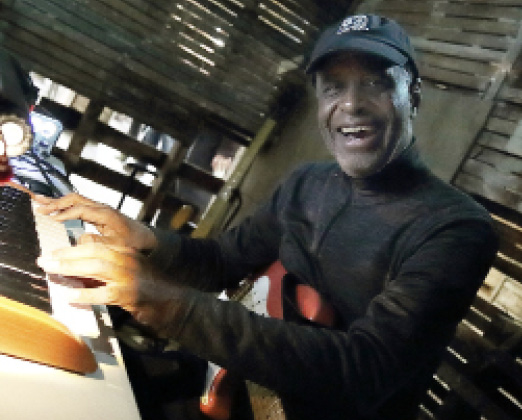In Volume V, Issue 1 of Rootstalk1, Dartanyan Brown told the first of three installments in a remarkable story. A native Iowan and African American, born in the Midwest at nearly the exact middle of the 20th Century, he was front-and-center for many of American culture’s most defining struggles, particularly the Civil Rights movement and the advent of revolutions in music and technology. Where many people content themselves with one career, Brown has had at least four: in journalism, in musical performance, in the tech sector and in education.
The story Dartanyan began in our last issue told of his musician parents, his early years as a journalist with the Des Moines Register2, and his adventures in the burgeoning musical—and cultural—scenes of the 60s and 70s, when he began playing Rock-n-Roll, blues and jazz with various Midwestern bands. In the spring of 1973, he hit the big time when he was called to join Chase, the Jazz-Fusion band fronted by seminal trumpet player Bill Chase3.
That’s where Dartantyan’s story picks up in this issue. Though he didn’t know it at the time, his story was destined to have a few more dramatic turns, and he was going to be at the forefront as our culture changed—dramatically—yet again.
As I write this, I realize that it’s 46 years ago this month (April 2019) since I packed up my gear and headed for the Des Moines airport, ready to fly off to Chicago into what would be one of the most significant periods of my life.
The flight from Des Moines wasn’t long, of course, and upon arriving at O’Hare Airport I was met by one of Bill Chase’s managers. With the late afternoon becoming evening, we whisked down the Dan Ryan Expressway into Chicago’s storied North Side to the corner of Rush(!) and Walton Streets—the site of The Universal Recording Corp4.
This is where the Chase band rehearsed and recorded their albums too?? Whoa!
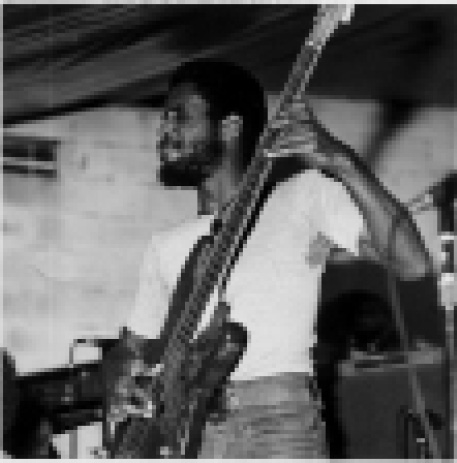
Dartanyan Brown onstage with Chase in 1973, “exploring the lyrical qualities of his ax”
Once inside, we took an elevator to the second floor where I was led down a short hallway and through a set of doors into the massive Studio A. There I saw my hometown friend Tommy Gordon5 seated at the drums in the center of what appeared to be a jungle of microphones and cables. On his left the four trumpet players—Jerry Van Blair6, Jay Sollenberger7, Carl Haefli and Bill Chase, at six foot four, literally towering over the other horn players who were warming up. On Tommy’s right was guitarist Tony DiCaprio8 and organist/electric piano/synthesizer player Wally Yohn9 from Phoenix, Arizona.

Bill Chase onstage with keyboardist/synthesist Wally Yohn
Surveying my new surroundings, I saw a big window on the south wall behind which was the control room with its massive (for those days) 24-input Harrison Console, 16-track Ampex tape machines, and, most importantly, one Murray Allen.10
Murray was chief engineer and arguably one of the most experienced audio engineers in the world. He oversaw recording sessions with virtually every major recording artist of the late 1950’s, and until his passing in 2006 he was the chief sound engineer for the Grammy Awards Show.
To digress for a moment, Universal Studios was the brainchild of Bill Putnam, Sr.11 who founded Universal Recording Corporation in 1946 in Evanston, Illinois. Putnam founded the company to investigate new recording techniques and to develop specialized recording equipment. In 1947, Putnam moved the company to Chicago, where the Harmonicats12 recorded the first pop song featuring artificial reverberation: “Peg o’ My Heart.” The song sold 1.4 million copies, and the subsequent jump in income and new business also brought about a jump in Universal’s stature in the music industry. Soon artists including Patti Page,13 Vic Damone14 and Dinah Washington15 were recording there, and Al Morgan’s “Jealous Heart16” became the second million-selling record the studio was associated with, coming out on the in-house Universal Records label.
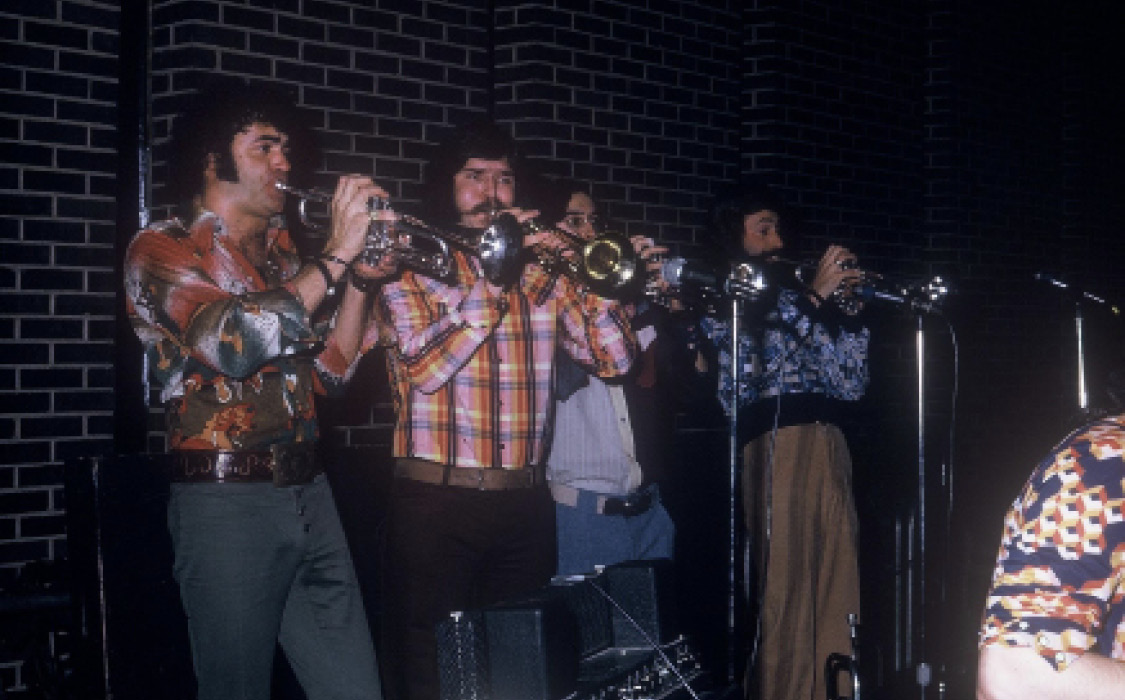
The Chase horn section in full cry: (from left to right) Bill Chase, Jim Oatts, Jay Sollenberger and Joe Morrissey
Universal was central to the development of experimental studio techniques including the first use of tape repeat in a recording, the first isolated vocal booth, the first recording with multiple overdubs of a single voice, early 8-track recording trials, and the first experiments with half-speed disc mastering.
On the spring day of my arrival, as I looked around Universal’s massive studio—with its once-white walls now a time-worn beige—I drank in the art, culture and technology that resided in this hallowed audio creation space. As an innocent kid out of Iowa, I really had no idea of the actual business of music, but looking around you could tell they were recording a lot more than just rock bands.
As I later learned, Universal turned out soundtracks for movies and television shows, orchestral performances, radio plays with sound effects, commercials for television, radio, limited distribution recordings for business, public service announcements and hundreds of other applications for sophisticated, cutting edge sound recording, mixing and distribution techniques. This would be my workplace for the next 15 months!
At the time, though, I realized that the next 15 minutes were the real challenge…. The time had come to pick up my instrument and make sense of the charts that were placed in front of me for my first rehearsal session.
The first chart we played was the band’s hit song “Get It On.17”
I’d heard it countless times. Beneath all the fury and energy, it’s really just a souped-up blues structure. I looked at the chart and was able to recognize the overall piece, but as we kicked it off I realized two things:
-
These guys played really fast, and
-
My bass sound disappeared in the mix due to my lighter ‘jazz’ approach to the chart.
I learned then and there that Chase was a jazz-ROCK band.
That meant that we could play as subtle as we wanted—at 120 decibels! Oh god, the little jazz club-type amp that I pushed my bass through was less than inadequate. (Imagine a kazoo with the Chicago Symphony Orchestra) The road crew went out and found a bigger amplifier for me and then came the next problem….
I knew “Get It On” because I had heard it a million times but what about the rest of Bill’s compositions?
Time signatures of 9/4, significant solo spaces, and very intricate rhythmic and harmonic devices demanded full attention (and sometimes that wasn’t enough). Here I was in Chicago thrown headlong into the deep end of the talent pool, and if I didn’t get it together fast…well…going back to Des Moines wasn’t a fun thought.
The band lived at the Marilyn Hotel less than a block from the studio. It was a busy place where traveling musicians stayed during their Chicago runs. It was there that I met guitarist Barry Finnerty18 and woodwind master Arnie Lawrence19. Both of them were playing and recording in Chicago with the great drummer and composer Chico Hamilton.20 Barry and I were both 23, and while this was his first ‘big time’ gig, a few years later, in 1978, he would record with the Brecker Brothers21 jazz-fusion band on Heavy Metal Be-Bop,22 and then, in 1981, with Miles Davis23 on The Man with the Horn.24
Arnie, born in 1938, was a veteran woodwind player who had played with Charles Mingus,25 Thad Jones,126 Maynard Ferguson,27 Clark Terry28 and Duke Pearson,29 and was first recorded in 1966, playing on Chico Hamilton’s The Dealer.30
As the three of us became friends, I related how tough it was for me to learn some of Bill’s music.
“Come on over to my room, I’ll show you some ways to learn faster,” said Arnie. And boy, did he. He was a natural teacher, and his sessions—on learning how to subdivide measures, how to deal with Latin clavé variations, and how to create rhythmic phrases—were mini-master classes without which I might not have survived the experience. Arnie Lawrence and I would meet again six years later at Duke University as Jazz-Artists-In-Residence with the National Endowment for the Arts.31
One more thing…
Now that I was actually playing bass with the band, there was yet another unsettling new development in the offing.
Chase fans familiar with the group’s sound on the first two albums know that Terry Richards32 and GiGi Shinn,33 were two of the most capable white blues shouters you could find in that day. These two guys had all the blue-eyed soul you could ask for.
Me? I weighed 145 soaking wet and my voice, while scat-singing-capable, was about as far as you could get from a classic “soul” voice.
When I arrived on my first day at Universal studios, I noticed that while we were playing the songs, there was nobody singing the songs. Curious.
Later, I found out why: Bill had decided (aided and abetted by Tommy Gordon) that I should be the new lead singer for Chase.
I didn’t believe it at first, but I was told this was not a joke, but my new reality. The number of vocal numbers was to be drastically reduced (and that was good) but I would be the one singing “Get It On” as the last song before the end of the show/encore (and that, as it seemed to me, was very bad).
I put on a “let’s-go-for-it” face to the band, but inwardly, I was aghast. There was no way I could fake a soul voice. Too thin, too reedy, no heft there, in my personal estimation.
After our first concert in El Paso, and for the next two shows, I was getting pretty low. Even with enthusiastic response from the audience, I still felt vaguely fraudulent—and I think Bill noticed because he took me aside.
“You’re in this band because you’ve got what it takes,” he told me. “Hell, you’ve got more than what it takes. Just be yourself and do the song your way.”
Boy, did that make a difference. I relaxed a bit about singing, and instead of trying to be ‘them,’ I discovered ‘me’. Tommy and I were now free to create a swinging rhythm section with guitarist Tony DiCaprio and keyboardist Wally Yohn.
Taking on the challenge of being lead vocalist/bassist with Chase on the road was its own reward. Discovering that my sound could be an important addition to the band produced a feeling more of gratitude than pride. In the ensuing months, we headlined with classic 60’s-70’s artists including Spirit,34 Jim Croce,35 Harry Chapin,36 Sly and the Family Stone,37 The Spinners,38 Kenny Rogers and the First Edition,39 and a bunch more that I don’t remember. So, though my transition to lead vocalist/bassist with Chase on the road had started weird, we got it done and all turned out well.
Chase on tour
The cool thing about a bus ride with the band is that you’ve got a lot of time to do whatever. Some guys practiced, some guys slept, some guys read, some guys talked, and talked and talked. Some of the best road stories you’ll never hear. Colorful and crazy, bawdy banditry, teary stories of lost loves, triumphant gigs in dive bars or crappy gigs in famous venues. Like sailors before them, itinerant artists relating stories full of humanity’s triumphs and tragedies. Road stories from the older musicians served to hip us younger guys (almost no girls in these bands) to the reality of maintaining your sanity and humanity while traveling 400-1,000 miles between engagements.
The memories of that first tour are a blur. What I do remember are some numbers:
5,000 people to see the band
140 decibels (inside an auditorium)
2 Ringing ears
1 sore wrist from signing autographs
400 watts (I needed a bigger amplifier)
1 burning question: Can I do this forever?
I discovered that being the lead singer for Chase was fun on the road, but in the recording studio, it turned out to be quite a different matter!
Straaaangs not strings
The recording experience at Universal Studios was awesome, but one moment remains hanging in my memory closet like a forgotten clown suit. There was a new song to record, a potential single titled “Run Back to Mama.” It was written by Jim Peterik40 and Bill Chase. The chorus had a tagline: “Will you always be tied to those apron strings?” It was a weird, pejorative little anthem to male superiority (and we actually had another piece entitled “Weird Song #1” on the record!) As I mentioned before, the previous two Chase lead singers were leather-lunged white soul shouters. Me? Not so much.
When producer Frank Rand41 would listen to me sing that tagline, he’d invariably stop the tape and ask me to “sing it blacker. He’d draw it out saying: “Don’t say ‘strings’ say ‘straaaaangs.’”
Well, we went through this frustrating ritual for another 10 attempts to ‘blacken up’ my delivery of the tagline before Frankie gave up and replaced me with Peterik, a white guy who could sing it as “soul” as Frankie wanted. I wasn’t in the least bit bothered about it because:
a. I couldn’t actually sing the style he wanted and,
b. The song was panned by Downbeat magazine42 as perhaps the most sexist song of 1974. So there’s that….
Boston—April, 1974
The Chase band was a virtual rollercoaster of experience for me. I joined in April 1973 and by April 1974, the band had broken up (twice!), reformed, recorded a great album and was now preparing to hit the road to promote it.
At that time, hit-making jazz musician Herbie Hancock43 was also completing his groundbreaking jazz-fusion album entitled Headhunters.44 Both Herbie and Bill Chase were signed to the same label—CBS/Epic Records—and the promotion department put us together on an East Coast tour covering Boston and New York City.
This was our second tour with Herbie. In mid-1973 we had played a series of shows in Boston together. Both bands hung out quite a bit, watching each others’ performances. Our drummer Tommy Gordon and I became friends with Herbie’s bassist, Paul Jackson.45
Several nights into the series, some of us decided to head out into the Boston evening to find food, fun, and who knows what else.
It was a clear starry night and the wind coming out of the East was cold and steady. Tommy had been a cab driver in Boston (that was a good thing for the rest of us). I’d never been to Boston before, and the streets are notoriously serpentine with intersections which angle in ways that would mystify Pythagoras. Tommy was in the back seat, Jim Oatts46 was driving and the rest of us were wildly riding with not a care in the world.
We somehow broke out of the maze of streets and got onto a stretch of freeway. The moon was full, joints were rolled as we rolled along enjoying the evening and our general living-the-dream circumstances. Blissfully unaware, Jim took an exit off the freeway. The exit, which we barely acknowledged, appeared to be a flyover that would take us back in the direction we had come from.
For a freeway overpass, it was a fairly steep climb and in the back seat, I could feel acceleration and gravity pulling me deeper into the cushions.
It was at that moment that Tommy sitting next to me said, “Ah, Jim stop the car…”
Well, his admonishment was lost in the din of the conversations and Jim certainly didn’t hear Tommy as he rocketed up the exit ramp, laughing with someone in the front passenger seat.
“STOP THE CAR NOW!!”
Yelling from the back seat, Tommy got Jim’s attention, and fortunately Jim instantly mashed the brake pedal bringing the car to a halt less than 300 feet from the lip of an unfinished freeway flyover hanging 20 or 30 feet in the air.
I’ll never forget the full vanilla moon above us almost beckoning, siren-like for us to come and meet her. We had almost played Jason to her siren call, somehow blissfully unaware of the DANGER NO EXIT—UNDER CONSTRUCTION sign that we had blown right by at the bottom of the ramp. We had been on our merry way to what could have been a tragicomic Rock ‘n Roll footnote.
I’m not really sure how long it took for Jim to hit reverse and back our way down the unfinished exit. It might have been an hour, with all of us sitting up there in silence contemplating what had almost happened. Of course, it might have been a couple of minutes of stunned silence followed by “holy crap, man.”
For one evening, we were thankful we could go back to the hotel, order room service and watch Johnny Carson on TV.
Almost a year later…. In April 1974, Chase—now with Walter Clark on drums—and Herbie Hancock’s Headhunters played Boston again, and you can imagine how thankful I was to be playing this gig after our experience the year before.
School? Famous band? School? Famous band?
There is an old saying: “Be careful what you wish for because you just might get it.”
Sly Stone put it a different way: “The nicer the nice, the higher the price.”
After a tumultuous year in rock ‘n roll’s fast lane I found myself onstage thinking: “Man, it would actually be great to be off the road and back in college again.” Contrary to popular lore, the reality of the traveling musician was often 180 degrees opposed to the Rolling Stone version. “Sex, Drugs and Rock ‘n Roll” could devolve into “stress, drudge and hard-as-rock rolls” in crappy restaurants. Personnel changes and the economics of keeping a nine-piece band afloat took their toll on Bill, but The Great Energy Crisis47 of 1973-74 really took the bloom off the rose.
We weren’t really paying attention to the international situation at the time, but during the Nixon administration, the emergence of the cartel of the Organization of Petroleum Exporting Countries48 (OPEC) raised the price of a barrel of oil from $3 a barrel to over $12 a barrel. That got our attention!
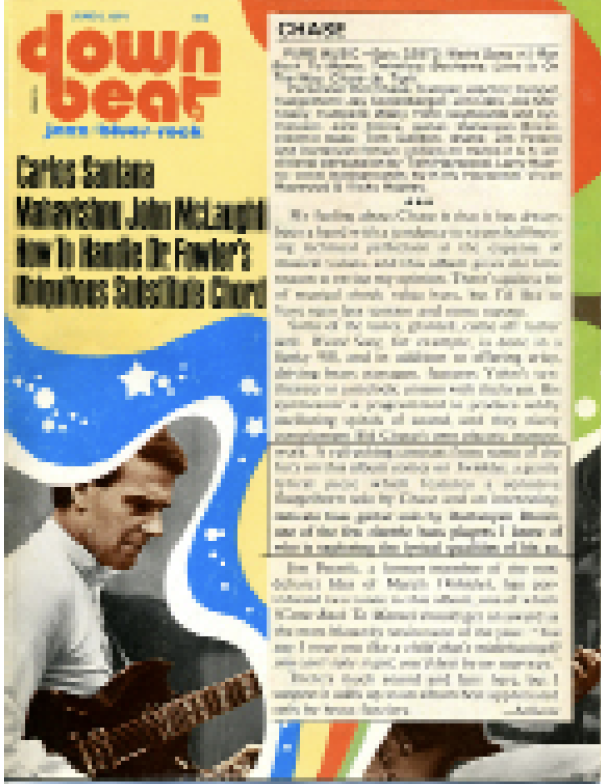
Downbeat Magazine’s review of “Pure Music,” featuring a prominent mention of Dartanyan Brown’s contribution
The resulting shock to the economy disrupted any business that was connected to the price of oil—which was pretty much the entire economy. The music business was materially impacted because:
-
Bands on the road (and practically every other form of commerce) were dependent on gasoline, and
-
The recording business was using petroleum-based vinyl for making phonograph records, the preferred medium of the booming music business.
Even very successful bands and traveling entertainment were negatively affected. For a successful but capital-intensive venture like the Chase band, the business model became almost immediately untenable.
The point was driven home during an 1,100-mile trip from Nashville to Boston. (That is, “We play in Nashville tonight guys, tomorrow night we play in Boston!”) This was during the midst of the energy crisis when stations were literally running out of fuel at any price. Driving through the Allegheny Mountains, we passed hamlet after hamlet with closed gas stations and “No Gas Available” signs dotting the landscape.
By this time, in the dead of night, our tanks were almost on “E,” and we were praying we wouldn’t run out of gas before reaching someplace that might loosely have been termed “civilization.” By the grace of the rock ‘n roll angels, we entered a downhill grade and coasted into a closed gas station, stopping beside its only gas pump. Exhausted, we all passed out until sometime around 6am when the owner tapped on our window, woke us up, filled our tank and sent our sad little delegation on its way to Beantown. We made the gig with about 30 minutes to spare on the other end.
At this point, I realized that many of the things I had learned to value were missing in a life lived out of an airport terminal or hotel suite. The realization slowly dawned that I really was a nerd at heart, and I missed school and more intellectual sustenance.
In the face of the rigors and struggle of touring, the stability and predictability of the academic life (as well as the unfinished business of my J-School degree) started to look better all the time. During a break in the tour, I actually went to Drake49 and inquired about the process of dropping back into college again.
The reply I received was positive, and I even found that a fellowship supported by the Register and Tribune was available.
Buoyed by the possibility of NOT being on the road forever, I rejoined the band. Because of my research, I didn’t feel as locked into the rock ‘n roller coaster as I had before. And that, as it turned out, was a very good thing.
Great music leavened the crazy life offstage.
Though I was conflicted about road life, the band itself was getting better all the time. My friend Tommy Gordon had left the band, but Walt Clark, our new drummer, was incredible. Our rhythm section came alive, pushing Bill, Wally Yohn, guitarist John Emma50 and the other soloists to even more incredible solos and ensemble work. So the whole “rock star” experience was really bittersweet.
We were in Houston, playing what would be our final show, when Bill took me aside after a set:
“Dartanyan, I have been thinking about dissolving the 4-trumpet version of the band and starting a new group with just myself and a rhythm section. Will you consider being part of the new group…?”
Seriously?! What he said rolled over my brain like an earthmover. He was offering me a bass player-vocalist gig and a position as a co-writer in a new band with new music. (Bill and I had already co-written a promotional project for the Gibson guitar company)
Now I was really conflicted. I hadn’t told anyone that I had been thinking about going back to school, and with this latest development, I realized I had some major decision-making to wrestle with.
Bill told me I should think about his offer and give him an answer at the next show, scheduled 10 days hence in Jackson, Minnesota.
I hadn’t seen my mother in months, so before heading to Minnesota, I grabbed a flight to Kansas City to visit her at Unity Village51—headquarters for the Unity Church founded by Charles and Myrtle Fillmore in 1889—in Lee’s Summit, Missouri.
Mom was in her last year of study on the path to ordination as a Unity Minister. She would ‘graduate’ in August 1975. It was now late July 1974 as I drove out to visit with the future Rev. Mary Alice Brown.
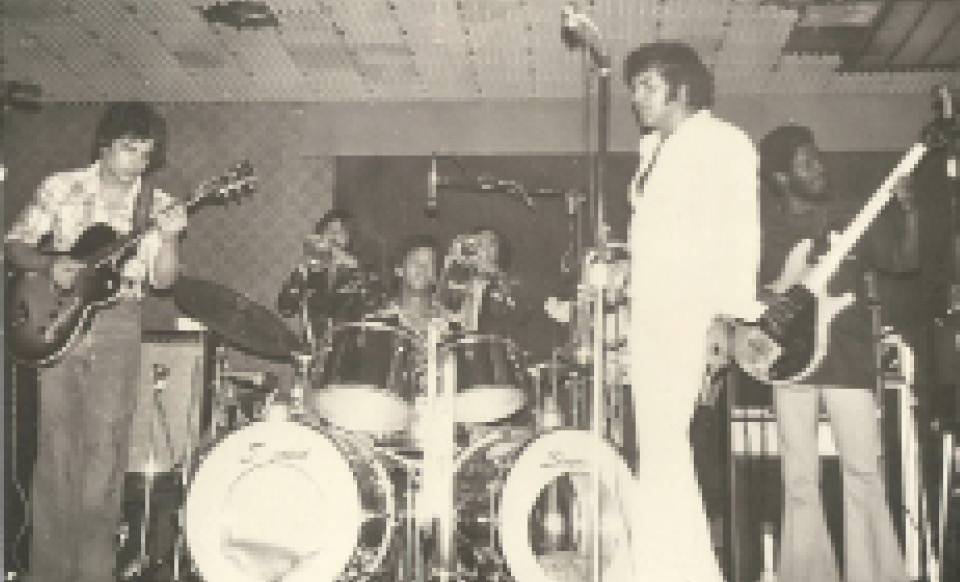
The final incarnation of the Chase band. From left, John Emma (guitar), Jim Oatts (trumpet), Walter Clark (drums), Jay Sollenberger (trumpet), Bill Chase and the author, on bass
Since I had left school under less-than-optimal circumstances nearly four years earlier, we had actually become able to laugh at how my act of “falling up” was truly a great lesson…if only we could discern what it was.
Well, now it was time to either ‘fall back’ into college or continue chasing a rock ‘n roll phantom that still seemed mighty real.
How was I to balance the fact that while, yeah, road life was hard, the rewards it offered were compelling? The band was great; we had survived a lot of shit together and now I was being asked to form an even closer relationship with Bill Chase, a man that I highly respected as a musician and now a good friend.
School? Famous band? School? Famous band?
These were the thoughts clanging endlessly in my head between July 20, and August 9, 1974. Like an angel on one shoulder and a little devil on the other, the dialog was constant.
Devil: “Dart, don’t be a square. You can always go to school, but you can’t always tour with a great band.”
Angel: “Now, Dartanyan, you know that you made a commitment to your education. Stop this madness and return to your ‘normal’ life.”
On August 9, I was driving with Jim Oatts, Jay Sollenberger and Joe Morrissey52—the Chase trumpet section—as we made the rain-soaked drive to Jackson, Minnesota from Oatts’ parents’ house in Jefferson, Iowa.
Bill, along with keyboardist Wally Yohn and new members Walt Clark and guitarist John Emma were flying in a private plane from Chicago for our concert at the Jackson County Fair.
We endured a combination of late summer tornado-like winds and sheeting rain and even hail at times. We barely made the 135-mile drive to Jackson and in normal times, I would’ve been with the guys flying from Chicago, where I lived.
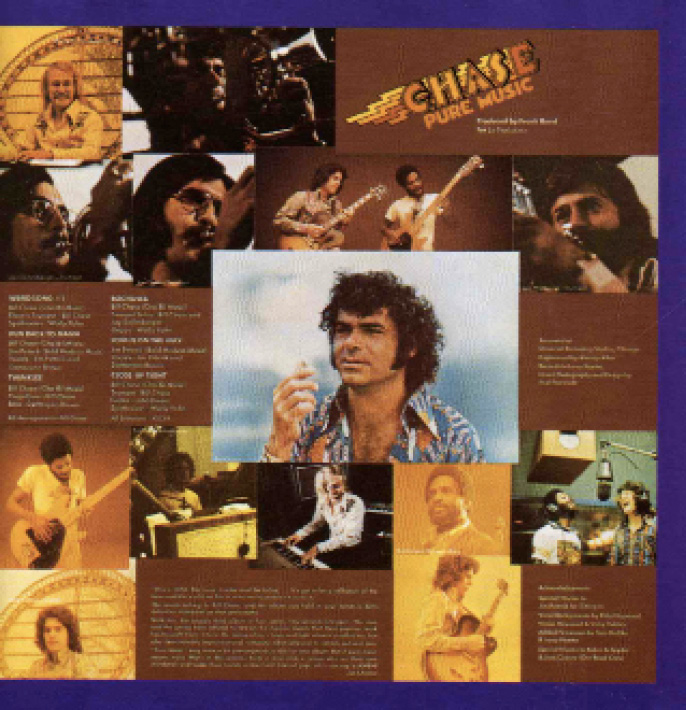
The liner notes for Chase’s third and final album, “Pure Music” with Dartanyan Brown appearing in four photos
My decision-making process seemed to mirror the storm outside, but I had finally decided what I should do. I was going to tell Bill my decision on seeing him at the show but….
We never ever saw each other again. The rest of us later learned that the plane carrying Bill Chase, Walter Yohn, John Emma and Walt Clark had crashed 300 feet short of the runway in the blinding storm, killing everyone on board. Suddenly and irrevocably, everything was over.
Returning to Chicago was pointless. It was time to close the loop and prepare for whatever life had in store for me next.
On my earlier visits, I had already begun processing the paperwork for my re-admission to Drake University, so by September 9, 1974, I began working with Professor Joe Patrick on completing a BA in news-editorial journalism. I also re-joined the Drake Jazz Band, directed by Robert Weast.53 I earned that J-school degree on August 5, 1975, the same day Reverend Mary A. Brown was ordained as a Unity Minister in Kansas City. The timing seemed sublime.
In the next issue of Rootstalk Dartanyan Brown will tell the final part of his remarkable story, in which he plunges into the Tech Revolution, and reconstitutes himself again in one of his longest incarnations—that of teacher.
References Listed
1 https://rootstalk.grinnell.edu/article/my-integrated-life-part-i
2 https://www.desmoinesregister.com
3 https://en.wikipedia.org/wiki/Bill_Chase
4 https://en.wikipedia.org/wiki/Universal_Audio#cite_note-2
5 https://cibs.org/events-programs/iowa-blues-hall-of-fame/tommy-gordon
6 https://www.discogs.com/artist/370888-Jerry-van-Blair
7 https://www.discogs.com/artist/390313-Jay-Sollenberger
8 https://www.discogs.com/artist/2817797-Tony-DiCaprio
9 https://www.discogs.com/artist/390315-Wally-Yohn
10 https://www.mixonline.com/recording/murray-allen-1930-2006-425060
11 https://en.wikipedia.org/wiki/Bill_Putnam
12 https://en.wikipedia.org/wiki/Jerry_Murad%27s_Harmonicats
13 https://en.wikipedia.org/wiki/Patti_Page
14 https://en.wikipedia.org/wiki/Vic_Damone
15 https://en.wikipedia.org/wiki/Dinah_Washington
16 https://en.wikipedia.org/wiki/Jealous_Heart
17 https://www.youtube.com/watch?reload=9&v=C4SW2Z3_d8I
18 https://www.barryfinnerty.com
19 https://www.allmusic.com/artist/arnie-lawrence-mn0000929868/biography
20 https://www.discogs.com/artist/70526-Chico-Hamilton
21 https://en.wikipedia.org/wiki/Brecker_Brothers
22 https://en.wikipedia.org/wiki/Heavy_Metal_Be-Bop
24 https://en.wikipedia.org/wiki/The_Man_with_the_Horn
25 https://mingusmingusmingus.com
26 https://thadjones.jazzgiants.net
27 https://en.wikipedia.org/wiki/Maynard_Ferguson
29 http://www.bluenote.com/artist/duke-pearson
30 https://www.allmusic.com/album/the-dealer-mw0000208016
32 https://www.discogs.com/artist/370882-Terry-Richards
33 https://www.discogs.com/artist/370886-G-G-Shinn
34 https://en.wikipedia.org/wiki/Spirit_(band)
36 https://harrychapinmusic.com
37 https://www.slystonemusic.com
38 https://en.wikipedia.org/wiki/The_Spinners_(American_R%26B_group)
39 https://en.wikipedia.org/wiki/Kenny_Rogers_and_The_First_Edition
41 https://www.discogs.com/artist/304937-Frank-Rand
43 https://www.herbiehancock.com
44 https://www.herbiehancock.com/music/discography/album/673
45 http://www.pauljacksonbass.com
46 https://www.iowarocknroll.com/jimoatts
47 https://www.history.com/topics/1970s/energy-crisis
50 https://www.allmusic.com/artist/john-emma-mn0001615986


